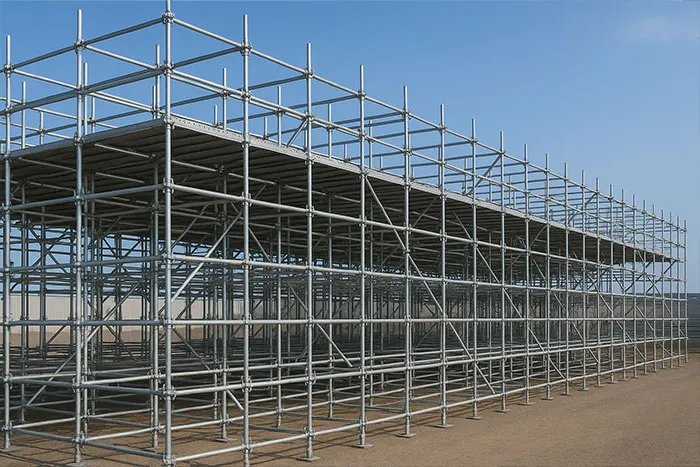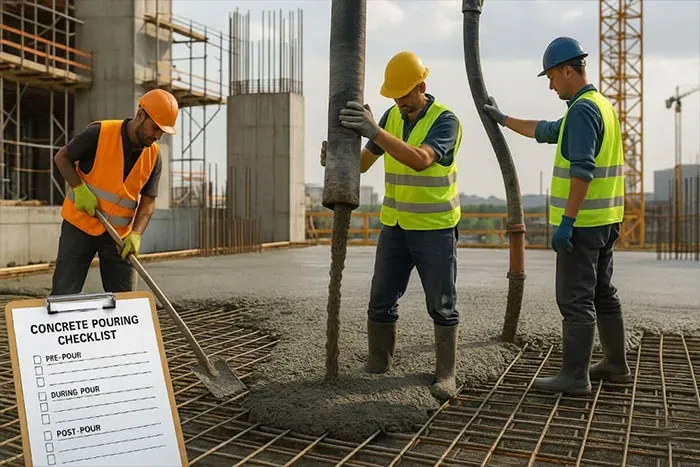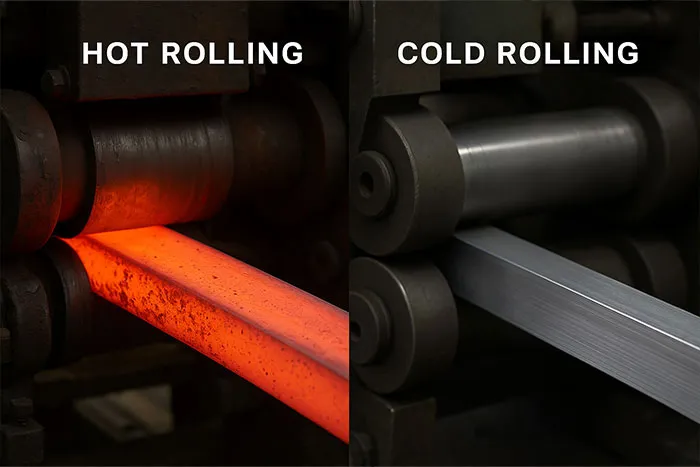
- Published:
- Written by: B.F.S Industries
Scaffold Inspection Checklist

FREE DOWNLOAD – B.F.S. HOLDING
Explore the full spectrum of services and industries covered by B.F.S. Holding.
In the fast-paced world of construction, where heights and heavy loads are part of the daily grind, safety cannot be an afterthought. Scaffolds are essential tools that elevate workers to complete their tasks efficiently, but they also pose significant risks if not properly managed. A thorough scaffold inspection checklist is the first line of defense against accidents, helping to identify potential issues like scaffold hazards or inadequate fall protection before they escalate into costly incidents. Industry experts report that regular safety inspections can reduce scaffold-related accidents by up to 80%, protecting lives and minimizing downtime.
This article dives deep into the essentials of a scaffold inspection checklist, guided by OSHA standards and industry best practices. Whether you are a site manager, engineer, or contractor, understanding scaffold stability, hazard assessment, and compliance requirements will empower you to maintain a secure work environment. We’ll cover everything from daily checks to risk assessment procedures, ensuring your team stays safe while boosting overall productivity.
By prioritizing construction site safety through structured inspections, you not only comply with regulations but also foster a culture of responsibility and proactive hazard management. Let’s explore how a well-implemented scaffold inspection checklist can transform your operations and strengthen construction site safety practices.
Understanding Scaffold Hazards
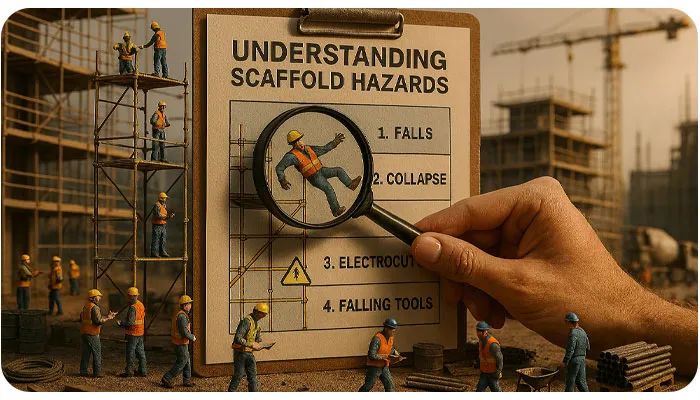
Scaffolds, while indispensable in construction, come with inherent dangers that demand constant vigilance. Common scaffold hazards include structural failures, slips from unstable platforms, and falls due to inadequate guardrails. Additional risks, such as electrocution when scaffolds are erected near power lines, or injuries from falling objects, make early recognition through a scaffold inspection checklist essential.
For example, overloading a scaffold beyond its capacity with tools or materials can lead to collapse. Weather conditions, including strong winds or rain, further increase instability, turning routine tasks into potential hazard zones. According to OSHA reports, falls from scaffolds account for a significant portion of construction fatalities, emphasizing the need for proactive safety measures.
To mitigate these risks, conduct a thorough risk assessment before scaffold setup. Identify site-specific concerns, such as uneven ground, nearby traffic, or loose debris, and address them promptly. Implementing scaffold safety tips, like using non-slip footwear, securing loose items, and maintaining clear access paths, significantly reduces accidents. Awareness of scaffold hazards is not only about regulatory compliance—it is a critical step in protecting your team and promoting a culture of safety on-site.
Scaffold Pre-Use Daily Inspection – BFS Industries
Location: ____________________
Project: ____________________
Date: ____________________ Time: ____________________
Scaffold Type: ____________________
Inspected By (Competent Person-Scaffolding): ____________________
| Section | Inspection Item | Yes | No |
|---|---|---|---|
| Site Conditions | Has work location been examined before start of work and all precautions taken? | ☐ | ☐ |
| Has the scaffold been set up according to manufacturer’s and/or engineer’s instructions? | ☐ | ☐ | |
| General Requirements | Can scaffold components support at least 4 times their maximum load? | ☐ | ☐ |
| Is the maximum load capacity known and communicated to employees? | ☐ | ☐ | |
| Are all platforms fully planked, in good condition, with max 1” gap? | ☐ | ☐ | |
| Are platforms at least 18” wide? | ☐ | ☐ | |
| Are platform units cleated or extending 6” over supports? | ☐ | ☐ | |
| Are guardrails installed on scaffolds over 6 ft. high? | ☐ | ☐ | |
| Can guardrails withstand 200 lbs force? | ☐ | ☐ | |
| Is the front edge less than 14” from face work? | ☐ | ☐ | |
| If mixed manufacturers are used, do parts fit safely together? | ☐ | ☐ | |
| Is scaffold at least 10 ft. away from power lines? | ☐ | ☐ | |
| Is platform free of clutter, mud, or tripping hazards? | ☐ | ☐ | |
| Supported Scaffolds | Has scaffold been built with 4:1 safety ratio? | ☐ | ☐ |
| If ratio > 4:1, is scaffold secured to structure? | ☐ | ☐ | |
| Is scaffold plumb, square, and level? | ☐ | ☐ | |
| Are diagonal braces/guy wires installed? | ☐ | ☐ | |
| Are U-bolts and saddles installed correctly on wires? | ☐ | ☐ | |
| Are guy wires installed on load-bearing members? | ☐ | ☐ | |
| Are legs and frames on base plates with mudsills? | ☐ | ☐ | |
| Are footings level, sound, and rigid? | ☐ | ☐ | |
| Are poles and uprights braced to prevent displacement? | ☐ | ☐ | |
| Are scaffold parts free of damage, rust, or cracks? | ☐ | ☐ | |
| Access | Is safe access provided for platforms above 2 ft? | ☐ | ☐ |
| If ladder is used, is it secured and extends 3 ft. above platform? | ☐ | ☐ | |
| Stairway-type Ladders | Is bottom step ≤ 24” above ground, ladder extends 36” above platform? | ☐ | ☐ |
| Are slip-resistant treads on steps and landings? | ☐ | ☐ | |
| Are stair rails (top & mid) on both sides of stairway? | ☐ | ☐ | |
| Use | Have workers been trained by a qualified person? | ☐ | ☐ |
| Is scaffold within rated capacity? | ☐ | ☐ | |
| Has scaffold been inspected by competent person? | ☐ | ☐ | |
| Are defective parts removed from service and tagged? | ☐ | ☐ | |
| Fall Protection | Are personal fall protection systems used where guardrails not feasible? | ☐ | ☐ |
| Falling Object Protection | Are toeboards (≥ 3.5”) installed to prevent falling objects? | ☐ | ☐ |
| Are screens/barriers installed for objects taller than toeboards? | ☐ | ☐ | |
| Is area below scaffold designated hard hat only, with warning signs? | ☐ | ☐ |
This daily scaffold inspection checklist is provided by BFS Industries to help ensure safety, OSHA compliance, and efficient construction site operations.
OSHA Standards for Scaffold Safety
OSHA standards form the backbone of scaffold safety, providing clear guidelines to prevent accidents and ensure construction site safety. According to 29 CFR 1926.451, scaffolds must support their own weight plus four times the maximum intended load, guaranteeing stability under all conditions. Competent persons are required to inspect scaffolds before each shift and after any event that could compromise their integrity, such as storms or heavy wind. Choosing the Best Scaffolding Type for your project is also crucial, as it directly affects compliance, worker safety, and overall structural stability.
Key requirements include fall protection for heights over 10 feet, using either guardrails or personal fall arrest systems. Platforms must be fully planked, with no more than a 1-inch gap between boards, and access points like ladders must be secure and stable. OSHA also emphasizes worker training, ensuring that employees understand scaffold erection, safe usage, and proper dismantling procedures.
Compliance with these standards is not optional—violations can result in fines, legal consequences, or even project shutdowns. For example, cross-bracing must be installed correctly to prevent swaying, and footings should be level and capable of bearing loads safely. By aligning your scaffold inspection checklist with OSHA standards and selecting the Best Scaffolding Type for your site, you not only ensure legal adherence but also enhance the overall safety culture on your construction site.
Key Components of a Scaffold Inspection Checklist
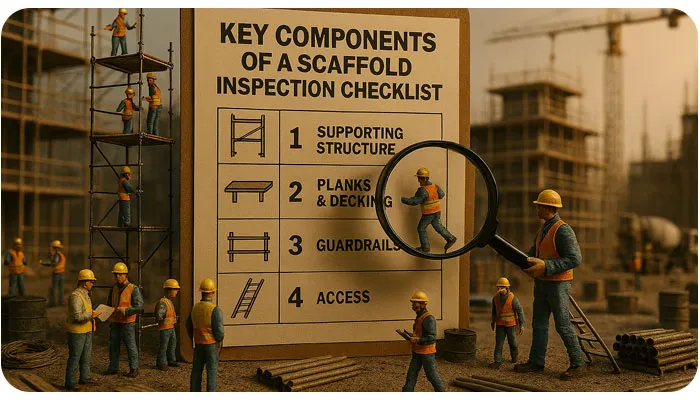
A robust scaffold inspection checklist covers multiple areas to ensure thorough safety checks. Start with the foundation: verify that base plates rest on firm, level ground, and use mud sills where necessary to enhance stability. Look for any signs of settling, erosion, or uneven surfaces that could compromise scaffold integrity.
Next, evaluate structural integrity. Inspect frames, braces, and pins for rust, bends, or cracks. Ensure all connections are tight, and confirm that the scaffold is plumb and square. This step is critical for preventing collapses, one of the most common scaffold hazards on construction sites.
Access and egress points also require attention. Ladders should be securely fastened, and gates or trap doors must operate smoothly. Platforms should include toeboards to prevent tools or materials from falling, in line with fall protection standards.
Finally, incorporate fall protection elements such as guardrails at 42 inches and midrails. Using this checklist daily helps identify potential issues early, promoting scaffold stability, worker confidence, and overall construction site safety. Consistent inspections not only prevent accidents but also reinforce a proactive safety culture.
Foundation and Base Inspection
The base is where scaffold stability begins, making it a critical part of any scaffold inspection checklist. Start by inspecting footings for levelness and load-bearing capacity, ensuring there is no soft soil, loose debris, or uneven surfaces underneath. Using mud sills or base plates helps distribute weight evenly, reducing the risk of tipping and structural failure.
Check screw jacks or adjustable bases for any damage, as these components allow for height adjustments on uneven ground. If the height-to-base ratio exceeds 4:1, installing guy wires or ties is necessary to prevent swaying and maintain scaffold integrity.
A practical tip is to measure the base width and height to confirm compliance with safety standards. Many scaffold incidents originate from uneven or unstable foundations, so addressing these issues during your risk assessment ensures a solid start for a safe scaffold setup and reinforces overall construction site safety.
Structural Integrity and Bracing
Proper bracing is essential to keep scaffolds rigid and stable against lateral forces. Inspect diagonal and cross braces to ensure they are securely pinned and free from defects. Frames should be perfectly vertical with no warping or bending, which can compromise scaffold stability. Choosing the right Shoring Scaffolding Systems can further enhance structural support, especially in complex or high-load projects.
Check all couplers and clamps for tightness, as loose components can lead to catastrophic failures. For modular systems like Cuplock Scaffolding, verify that all cups are properly locked, providing enhanced structural integrity and overall safety.
Incorporating these inspections into your scaffold maintenance checklist not only prolongs the life of your equipment but also helps prevent hazards such as collapses. Regular checks here are crucial for maintaining compliance with OSHA standards and reinforcing a culture of construction site safety.
Platforms and Decking
Scaffold platforms must be sturdy and fully decked to ensure worker safety. Use scaffold-grade planks that overlap by at least 12 inches and extend at least 6 inches beyond their supports. Gaps larger than 1 inch are unacceptable, as they increase the risk of trips and falls.
Inspect planks for cracks, splits, or slippery substances such as oil or mud. Install toeboards at least 3.5 inches high to prevent tools or materials from falling onto workers below. For wet or slippery conditions, incorporate non-slip surfaces to further enhance safety.
This part of the scaffold inspection checklist directly affects fall protection and overall construction site safety. Regular attention to platforms and decking helps prevent accidents, ensuring a secure work environment for all personnel.
Access and Egress Points
Safe entry and exit are essential components of scaffold safety. Ladders should be positioned at a 4:1 angle and securely fastened at both the top and bottom. Stair towers must be equipped with sturdy handrails to provide additional support.
Avoid climbing on scaffold frames; always use designated access points. Gates and trap doors should self-close to prevent accidental falls. These measures are part of scaffold safety tips that reduce the risk of accidents during transitions between levels.
Including access and egress checks in your daily scaffold inspection checklist ensures ongoing compliance, promotes worker safety, and reinforces a proactive safety culture on construction sites.
Fall Protection Systems
Fall protection is essential for scaffolds at heights above 10 feet. Guardrails should include top rails (38–45 inches), midrails, and toeboards to prevent tools or materials from falling onto workers below.
When using personal fall arrest systems, ensure that anchor points are secure and rated for at least 5,000 pounds. Inspect harnesses and lanyards regularly for wear or damage, and provide thorough training on their proper use, as required by OSHA standards.
Implementing robust fall protection measures safeguards against one of the most common scaffold hazards, boosting worker confidence and maintaining construction site safety at elevated positions.
Daily vs. Periodic Scaffold Inspections
Scaffold inspections can be divided into daily and periodic checks, each serving a distinct purpose.
Daily inspections are quick scans conducted before each use, focusing on visible defects such as loose bolts, damaged planks, or unsecured guardrails. A competent person performs these checks to ensure the scaffold is ready for safe operation.
Periodic inspections, carried out weekly or after any alterations, are more comprehensive. They involve load testing, structural integrity checks, and full disassembly evaluations.
The frequency of inspections should match site usage. High-traffic or complex construction sites require more frequent reviews. Integrating both daily and periodic inspections into your scaffold inspection checklist creates a layered safety approach that protects workers and maintains construction site safety.
Comparison Table:
| Aspect | Daily Inspection | Periodic Inspection |
|---|---|---|
| Frequency | Before each shift | Weekly or after changes |
| Scope | Visible defects | Comprehensive, including load and structure |
| Time Required | 15–30 minutes | 1–2 hours |
| Focus Areas | Platforms, access, fall protection | All components, stability tests |
Using both daily and periodic inspections ensures hazards are caught early, enhancing overall safety and compliance with OSHA standards.
Scaffold Maintenance Checklist
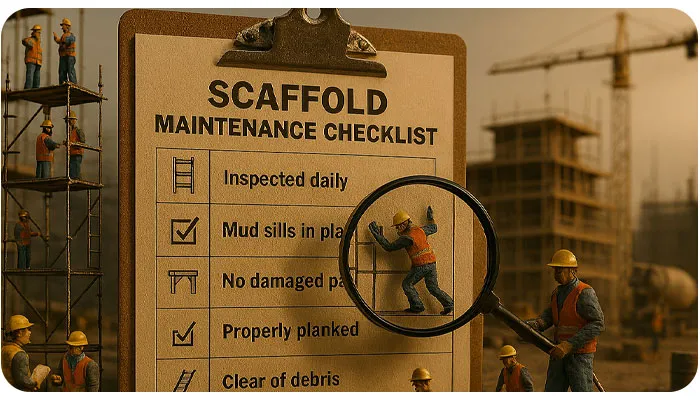
Regular scaffold maintenance is essential for prolonging equipment life and ensuring ongoing construction site safety. Start with cleaning: remove debris, paint, mud, or other materials that could hide defects or create slip hazards.
Inspect scaffolds for corrosion, especially on metal components, and lubricate moving parts such as casters to maintain smooth operation. When not in use, store scaffolds indoors to protect them from weathering and environmental damage.
Replace damaged or worn parts immediately—never improvise with incompatible components. For trusted replacement parts, consider providers like bfs industries, ensuring genuine items for optimal compatibility and safety.
A sample scaffold maintenance checklist includes:
Clean all components after each use.
Check for rust, dents, or wear monthly.
Lubricate joints, casters, and moving parts.
Document repairs and tag out any faulty equipment.
Following these maintenance steps prevents hazards, extends scaffold lifespan, and ensures compliance with OSHA standards.
Risk Assessment in Scaffold Use
A thorough risk assessment helps identify potential dangers before they turn into accidents. Begin by evaluating site conditions, load requirements, and environmental factors such as wind, rain, or uneven surfaces.
Classify risks according to severity: high for potential falls, medium for overloads, and low for minor issues. Implement appropriate controls, like additional bracing, guardrails, or barriers, to mitigate these hazards.
Engage your team in the assessment process to ensure understanding and buy-in. Document all findings, and review them after project completion to improve future scaffold safety practices.
A practical numbered process for scaffold risk assessment:
Identify hazards (e.g., uneven ground, overhead power lines).
Assess likelihood and severity of each hazard.
Implement controls (e.g., fall protection systems, proper load distribution).
Monitor and review effectiveness regularly throughout the project.
Conducting risk assessments proactively complements your scaffold inspection checklist, minimizing accidents and reinforcing a strong safety culture on construction sites.
Scaffold Safety Tips for Construction Sites
Practical scaffold safety tips can significantly improve worker protection and reduce accidents on construction sites. Always train workers on proper scaffold erection, use, and dismantling according to OSHA standards.
Ensure all personnel use appropriate PPE, such as hard hats, safety harnesses, and non-slip footwear. Avoid overloading scaffolds—always know the maximum load capacity for each structure. Monitor weather conditions and dismantle scaffolds in high winds or during severe storms.
It is also essential to understand the Difference Between Shoring and Scaffolding: shoring provides support to structures, while scaffolding supports workers during construction. Encourage workers to report hazards or unsafe conditions without fear of repercussions.
Incorporate these tips into daily routines to strengthen construction site safety:
Secure all tools and materials to prevent drops.
Maintain clear walkways around scaffolds to avoid trips.
Conduct weekly toolbox talks on scaffold hazards and safe practices.
Integrating these practices into your daily scaffold inspection and maintenance routines ensures a proactive approach to worker safety and compliance.
Advanced Topics in Scaffold Compliance
Beyond basic safety checks, scaffold compliance extends to specialized setups. For suspended scaffolds, inspect ropes, hoists, and rigging hardware rigorously to ensure they can safely bear loads and resist wear.
Integrating technology can improve inspection efficiency. Use apps or digital platforms for maintaining scaffold inspection checklists, tracking issues, and documenting completed inspections. This helps teams stay organized and maintain records for regulatory audits.
Stay updated on changing regulations, as OSHA revisions can directly impact your inspection and maintenance procedures. For example, a construction site that previously used improper bracing experienced a scaffold collapse. A thorough post-incident risk assessment and updated compliance measures prevented recurrence.
For complex scaffold setups, engage certified inspectors to verify structural integrity and proper installation. Following these advanced compliance measures ensures long-term safety, enhances operational efficiency, and reinforces a proactive construction site safety culture.
Conclusion
A scaffold inspection checklist is far more than a formality—it’s a crucial tool for saving lives in the construction industry. By identifying scaffold hazards, adhering to OSHA standards, and performing regular inspections, you create a safer and more productive work environment. From foundation and structural inspections to platforms, access points, and fall protection systems, every element contributes to overall scaffold stability and regulatory compliance.
Remember, safety is a shared responsibility. Incorporate these best practices, utilize the checklists provided, and train your team consistently. Prioritizing scaffold safety tips and conducting thorough risk assessments ensures not only legal compliance but also protects your most valuable asset: your workforce.
Take action today: review your current scaffold inspection checklist, make necessary updates, schedule training sessions, and commit to daily inspections. Your proactive approach to construction site safety could prevent the next accident. Stay safe, stay compliant, and build with confidence.
For more guidance or high-quality scaffold systems, consider bfs industries and specialized setups like Cuplock Scaffolding to maintain top-tier safety standards. Understanding the Difference Between Shoring and Scaffolding ensures the right support structures are in place for both workers and projects.
